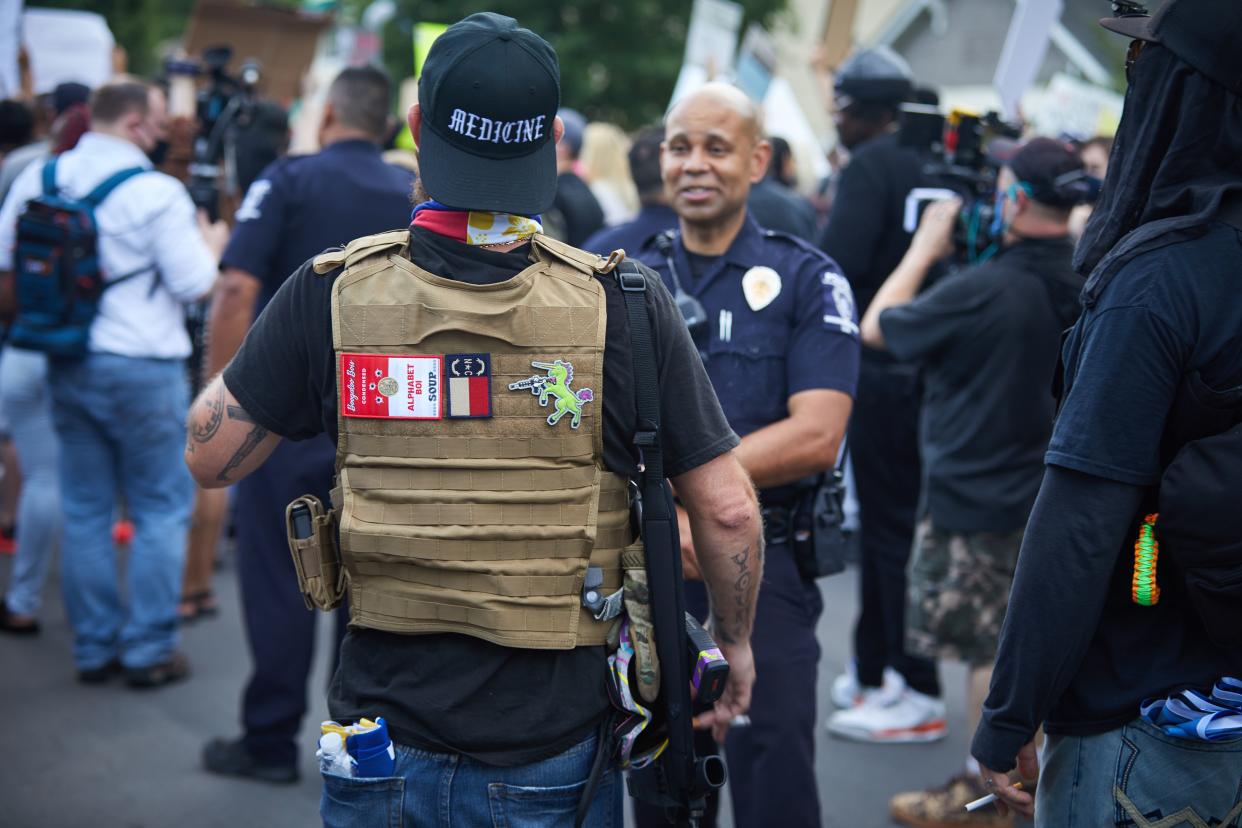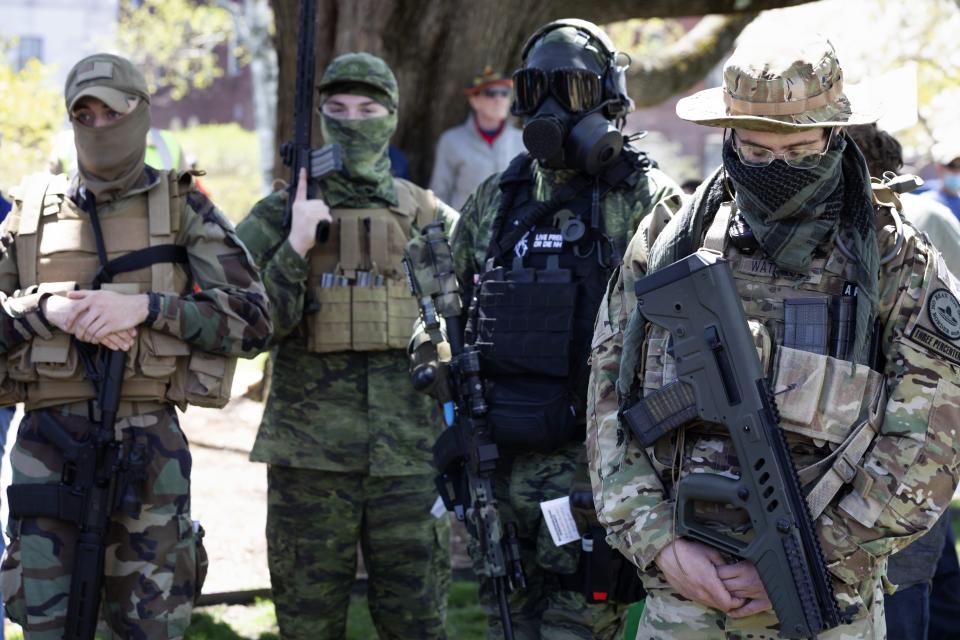'Boogaloo' on the loose: Experts warn Congress about extremism on the right

Authorities who study extremism told Congress Thursday that far-right groups, not the radicals of antifa, currently pose the most serious threat of political violence in America — including attacks on the police.
“The facts are right now that right-wing extremism is the bigger problem. That’s where the violence is coming from,” said Heidi Beirich, the recent co-founder of the Global Project Against Hate and Extremism and former director of the Southern Poverty Law Center’s Intelligence Project, where she spent the past two decades tracking and reporting on far-right extremist activity in the U.S.
Beirich was called to testify Thursday as part of a virtual hearing of the House Homeland Security Subcommittee on Intelligence & Counterterrorism, along with JJ MacNab, a fellow at George Washington University’s Program on Extremism, and John Donohue, the former chief of strategic initiatives for the New York City Police Department and a fellow at Rutgers University’s Miller Center for Community Protection and Resilience.
The subject of the hearing, led by subcommittee Chairman Max Rose, D-N.Y., was “assessing the threat of accelerationists and militia extremists,” such as members of the so-called boogaloo movement, which has recently become the subject of increased national interest following the arrests of several alleged boogaloo members on charges mostly related to violent actions or plots relating to the Black Lives Matter protests. Among them was an active-duty Air Force sergeant arrested in May and charged with fatally shooting two law enforcement agents in California, including one federal security officer, and injuring two others.
Rose made a point of declaring at the top of the hearing that “this ain’t about politics today.”
“If there’s something happening [anywhere] on the political spectrum that involves violence, upending society, threatening institutions, we gotta look at it,” Rose said, insisting that “it is incredibly irrelevant to me which groups we look at so long as we are looking at the principal ones that threaten people’s lives.”

Since late May, when protests against police killings of Black people began spreading to cities around the country, there have been dueling narratives about who was responsible for instigating violence, including damage to property and clashes with police, at the otherwise largely peaceful demonstrations.
President Trump and others within his administration, including Attorney General William Barr, have consistently sought, without evidence, to blame violent activity at these protests on antifa, an amorphous movement made up of various radical leftists and anarchist groups united in their willingness to use violence against neo-Nazis, white supremacists and anyone else they consider to be “fascists.”
At Thursday’s hearing, Republican Rep. Mark Walker, the ranking member of the Subcommittee on Intelligence & Counterterrorism, insisted that antifa is not just “a conservative talking point” and should be reviewed along with other violent extremists, including those with ties to white supremacy, antigovernment militias and other far-right accelerationist movements, such as the boogaloo.
“Over the past three months, there’s been a consistent effort by antifa supporters to infiltrate protests to lay siege to government buildings and target law enforcement,” said Walker.
However, a growing body of evidence, including intelligence reports, leaked law enforcement documents, as well as a number of indictments filed by Barr’s own Justice Department, has revealed significant threats against police and protesters by followers of far-right accelerationist and antigovernment militia movements, including the boogaloo. There has been little evidence of similarly coordinated efforts by groups associated with antifa.
In her written testimony, MacNab addressed recent efforts to paint “Antifa as the Fictional Enemy.”
“Known for confronting racists and right-wing militant groups at protests, causing property damage, and engaging in street violence, the various subgroups that make up Antifa are not without fault,” wrote MacNab. “They are not, however, the hyper-violent army that anti-government extremists make them out to be.”
MacNab acknowledged that “in the last two months, there has been a noticeable rise in left-wing private paramilitary groups.” However, while “the right-wing/left-wing labels may not be as clear as they once were,” she wrote, “the overwhelming majority of anti-government extremists are still right-wing.”
MacNab also sought to disentangle the somewhat confusing web of extremist ideologies that have come to identify with the boogaloo, emphasizing that the white supremacist wing of this movement is much smaller than the antigovernment extremist faction.
“Both movements want to tear the nation apart, to accelerate the downfall of society so that they can rebuild it to fit their idea of utopia, but they have different visions of what that utopia entails,” she wrote in her statement.

During the hearing Thursday, MacNab said that “most boogaloo members are libertarian anarchists who hate cops.”
“Guns are the common denominator in most antigovernment extremist groups,” she added. “Racism is not.”
During Thursday’s hearing, MacNab also explained that while the Hawaiian shirts, igloo patches and seemingly jovial jargon associated with the boogaloo (a term that itself evolved from an internet joke to refer to the anticipated civil war) are new, the disparate movement that has evolved around the boogaloo is simply the latest iteration of the broader antigovernment extremist movement, a loosely affiliated network of right-wing groups.
“The idea of a second American revolution, where armed patriots gather, rise up and overthrow the tyrannical government has been the dream of the antigovernment extremist movement for decades,” she said.
Over the last several months, she continued, “renewed conversations about gun control laws and restrictions, the COVID-19 pandemic, the recent mainstreaming of ‘deep state’ and anti-vaccine conspiracy theories, high unemployment rates, civil unrest in major U.S. cities, and the extreme divisiveness plaguing the upcoming general election have triggered a recent rebirth in the segment of the movement that focuses on firearms.”
This resurgence of antigovernment extremism coincided with the spread of boogaloo jokes and memes from the 4chan and Reddit boards where it originated to more mainstream social media platforms like Facebook and Instagram, where the term was adopted by other antigovernment militants.
The boogaloo aesthetic and jargon grew increasingly popular among antigovernment and pro-gun groups on Facebook after a number of militants in Hawaiian shirts and boogaloo patches were seen among the more than 22,000 mostly armed protesters at a gun rights rally in Richmond, Va., in January. Antigovernment militia groups like the Oath Keepers and Three Percenters soon began co-opting the boogaloo identity (including the Hawaiian shirts) within their Facebook groups, while on more secure message forums like Discord and Telegram, white supremacists and neo-Nazis were doing the same.
Days before the Richmond rally, the FBI arrested three members of the violent white supremacist accelerationist group the Base, who had allegedly plotted a shooting at the scene to create chaos. It was one of the first prominent examples of the accelerationist strategy of usurping otherwise peaceful gatherings to provoke armed confrontation.
Over the next several months, mainstream social media platforms, particularly Facebook and its private groups, served as a breeding ground for the boogaloo movement, as members of other antigovernment groups were drawn to boogaloo-themed pages. As the U.S. became the epicenter of the coronavirus pandemic, these groups helped spread disinformation and conspiracy theories about the virus, and fomented opposition to lockdown measures. Followers of the boogaloo began showing up at reopen protests, and later, the nationwide demonstrations against police brutality and racial injustice sparked by the police killing of George Floyd in Minneapolis in May. At least one group of self-identified members of the boogaloo movement, who were arrested last month in an alleged plot to incite violence at a Black Lives Matter protest in Las Vegas, had originally met at a reopen Nevada rally, according to prosecutors.
However, Facebook did not take action to stop the violent movement spreading across its platform until late last month, after several alleged boogaloo followers were arrested on charges mostly related to violent actions or plots relating to the Black Lives Matter protests.

Amid an ongoing advertiser boycott over the social network’s policies on hateful content, Facebook announced on June 30 that it had removed 220 Facebook accounts, 95 Instagram accounts and 106 groups associated with the boogaloo for violating its policies against organized violence, as well as an additional 400 groups and over 100 pages associated with the movement. The statement also included the somewhat confusing announcement that Facebook was officially banning from its platform “a violent US-based anti-government network” that uses the term boogaloo “but is distinct from the broader and loosely-affiliated boogaloo movement because it actively seeks to commit violence.”
“The true accelerant of these movements is the internet,” Beirich wrote in her prepared testimony. Beirich compared modern extremists’ use of mainstream internet platforms to spread their hateful ideology and inspire violence to the way “Hitler used the new radio to push his views into German families’ homes, thereby radicalizing an entire country into genocidal thinking.”
Beirich and the other witnesses urged Congress to take action to stop the spread of these violent movements through social media, and called for oversight to ensure that tech companies are held accountable for enforcing clear and consistent policies against the kind of content used to recruit people to these movements and inspire acts of violence.
“Congress has oversight responsibility to find out what the heck is going on in the social media world on this front,” she said. “I would suggest Congress call the tech companies to account for what’s in their terms of service and how they are enforcing their terms of service.”
In a question posed to the panel, Rose asked whether, by failing to crack down on the growing threat posed by these extremist movements, Congress would be unnecessarily putting the lives of law enforcement officials and law-abiding citizens alike at risk. All three experts agreed that the answer was yes.
While Beirich warned that inaction from Congress on the spread of these movements via social media could lead to mass attacks like the deadly shooting at a Walmart in El Paso last summer that left 22 dead, MacNab said it remains to be seen whether and how the violent surge of these particular movements would continue long-term. “Short-term,” she said, “I think we are looking at mass casualties.”
“It could be three, it could be 50. It could be protesters, it could be cops, it could be press, it could be medical workers,” she said, predicting that deadly attacks could be instigated by a variety of triggers, whether it’s renewed coronavirus lockdown orders, ongoing civil unrest, the upcoming presidential election or any kind of effort to impose new gun control legislation.
“As long as there is chaos these groups will thrive,” said MacNab. While some members of extremist militias are waiting for a catalyst to launch the violence, many others, she said, “will do what they have to do to bring chaos to the situation.”
Simply put, MacNab told the subcommittee, “if you do nothing, people will die.”
_____
Read more from Yahoo News:



